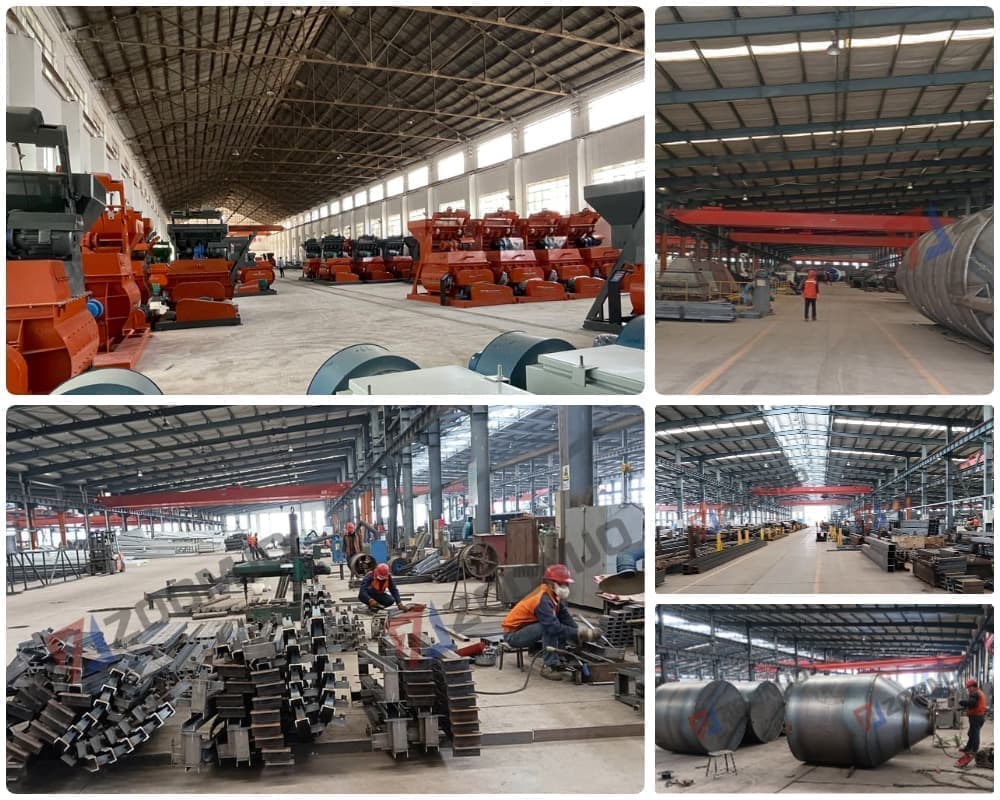Top Concrete Batching Plants for 2025

As 2025 approaches, the construction industry's growing emphasis on efficiency, sustainability, and adaptability is driving significant growth in demand for cutting-edge concrete batching plants. Currently, the construction industry is undergoing a profound transformation to proactively address growing environmental challenges and changing market demands.
Key trends in the transformation of the construction industry
The main factors driving the transformation of the construction industry are multifaceted and include the following two aspects:
-
The rise of sustainable building practices is driving innovations in building materials and construction methods, for example, the growing demand for high-performance concrete, which is directly contributing to advances in concrete mixing plant technology to meet higher standards.
-
The juxtaposition of policy orientation and market opportunities is also encouraging companies to adopt more advanced production equipment and management modes in order to improve production efficiency, reduce costs and maintain an edge in the highly competitive market.
Therefore, modern concrete mixing plant, as the key link of concrete production, is developing towards automation, intelligence and environmental protection.
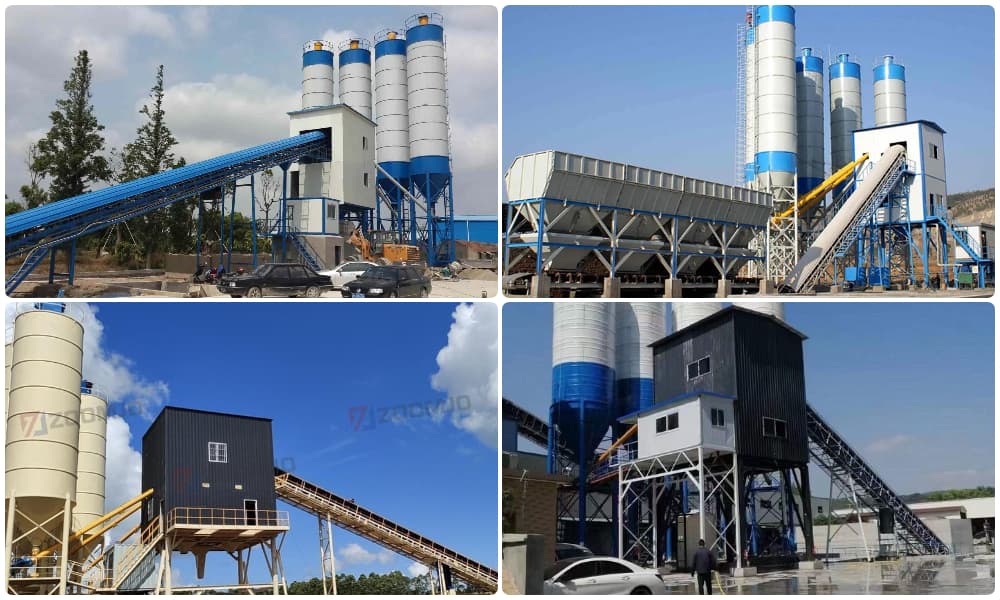
The key role of cutting-edge concrete batching plant
Cutting-edge concrete batching plants play a crucial role in this profound transformation of the construction industry. Not only do they significantly improve the efficiency of concrete production, they also effectively control the use of a wide range of raw materials, thereby minimising waste and reducing costs. These state-of-the-art batching plants typically have the following key features:
-
Highly accurate batching systems: Advanced metering and control technology ensures that every material is placed exactly where it needs to be to optimise the final quality and performance of the concrete.
-
Intelligent control and management systems: Integrate advanced sensors, data acquisition and analysis technologies to achieve real-time monitoring and optimal control of the production process, significantly improving responsiveness, flexibility and automation during the production process.
-
Excellent environmental protection and energy-saving design: Many new machines adopt highly efficient energy-saving technologies and environmentally friendly materials, such as waste heat recovery systems and dust control systems, to minimise energy consumption and carbon emissions during the production process, in line with the requirements of sustainable development.
Concrete Batching Plant Overview
A concrete batching plant, also known as a concrete mixing plant, is a complete set of equipment capable of producing concrete by uniformly mixing a variety of ingredients such as aggregates (e.g. rock, gravel, sand), fly ash, cement, silica fume, slag, water and other admixtures. The prepared ready-mixed concrete will be transported to the construction site via a mixer transporter (a truck with a rotating drum). The types, sizes, benefits and limitations of concrete batching plants available in the market vary, so choosing the best one is not an easy task. This article will help you better understand these machines so you can choose the most appropriate solution for your organisation to complete projects more efficiently.
Components of a concrete mixing plant
A mixing plant has a wide range of components, including the following key units:
-
Cement Weighing Unit: Used to accurately measure the amount of cement used to ensure the accuracy of the concrete proportions.
-
Water metering unit: Used to accurately measure the amount of water used, also an important part of ensuring the quality of concrete.
-
Admixture metering unit: used to accurately measure the amount of various additives (such as water reducing agent, retarder, etc.) to improve the performance of concrete.
-
Mixer: It is the core equipment of the mixing plant, responsible for mixing cement, water, aggregate and additives into concrete.
-
Aggregate Silo/Batching Machine: It is used to store and measure various kinds of aggregates (e.g. sand, stone, etc.) and batch them according to the proportioning requirements.
-
Conveying system: including belt conveyor, inclined belt conveyor, elevator (bucket elevator, inclined lifting elevator), etc. It is responsible for conveying materials such as aggregate, cement, etc. to the mixer.
-
Cement silo/cement tank: used for storing bulk cement.
-
Control system: It is used to control the operation of the whole mixing plant, including material metering, mixing time, unloading and so on.
The layout and configuration of these components may vary according to the type of mixing plant and specific requirements, such as the choice of conveying method (belt conveying or hopper lifting), the structural form of the mixing building and so on.
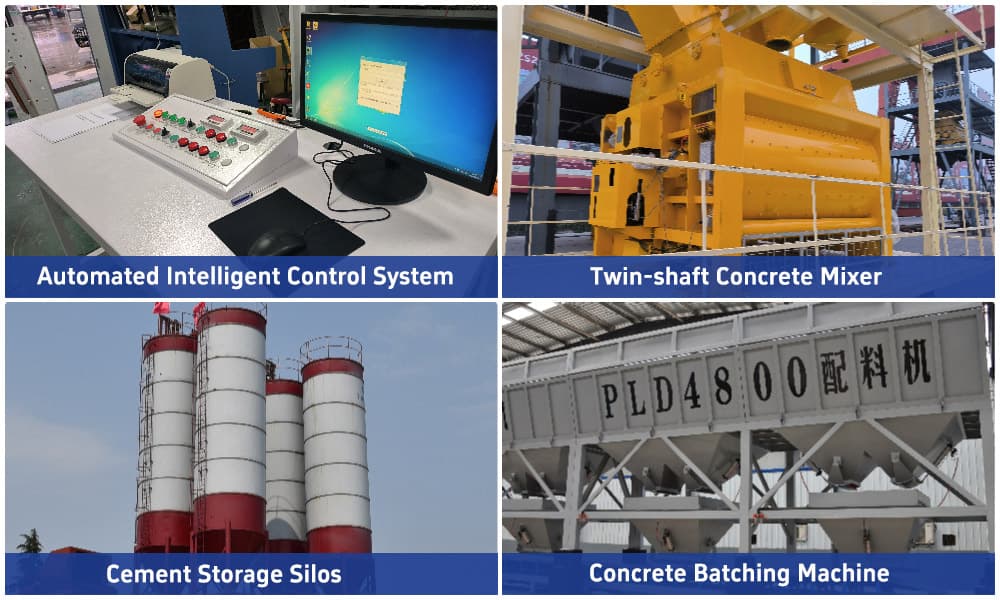
Common types of concrete mixing plants
There are many common types of concrete mixing plants on the market , which can be classified according to their structural forms, functional characteristics and aggregate conveying methods. A few of the main types are described in detail below:
1. Stationary Concrete Batching Plant
Stationary concrete mixing plant is usually installed in a specific location and is suitable for large-scale construction projects or sites that require concrete for a long period of time. Its main features include:
-
Continuous and stable concrete supply: capable of providing continuous concrete production for large-scale projects.
-
High production efficiency: suitable for large-scale concrete needs, with typically high production capacity.
-
Robust structure: designed with long-term stability and durability in mind.
Common models include the HZS series, such as HZS25, HZS50 and HZS120, with production rates ranging from 25 cubic metres to 120 cubic metres per hour.
2. Mobile concrete mixing plant
Mobile concrete mixing plant is a kind of flexible mixing equipment, suitable for construction projects that require frequent transfer. Its features include:
-
Easy to transport and install: all equipment is integrated on a trailer unit for quick movement and on-site assembly.
-
Adaptable: it can be used in a wide range of projects such as highways, bridges, hydropower, etc. It is especially superior in projects with short construction periods.
-
High degree of automation: usually equipped with a fully automatic control system for simple operation and high productivity.
Common models, such as YHZS series, have productivity ranging from 25 cubic metres to 75 cubic metres.
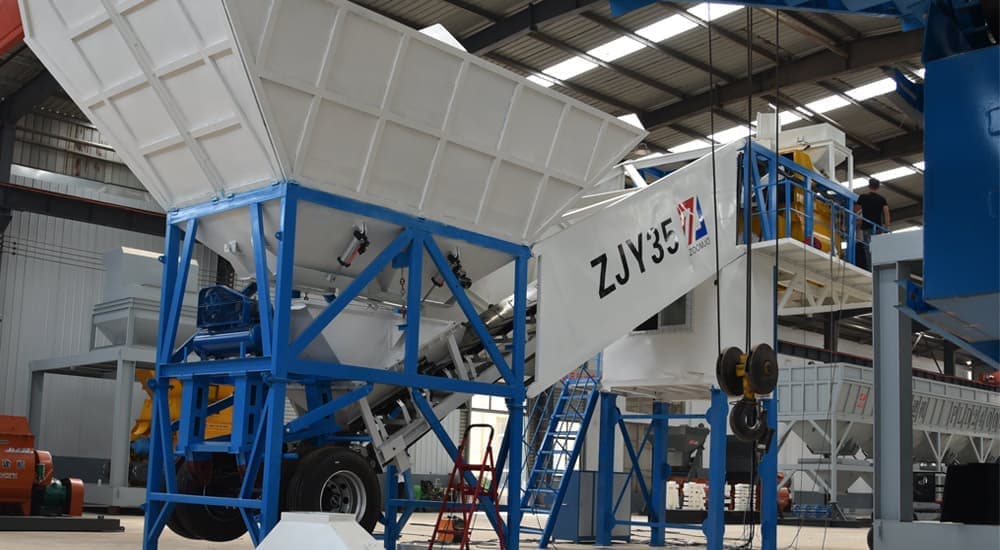
3. Foundationless concrete mixing plant
Foundationless concrete mixing plant is a new type of mixing equipment designed without foundation, suitable for complex geological conditions or where rapid deployment is required. Its features include:
-
Quick installation: no foundation is required, saving installation time and cost.
-
High flexibility: can be moved and set up quickly in different locations, suitable for temporary construction projects.
-
Compact: designed for ease of transport and operation, usually with a small footprint.
This type of mixing plant is suitable for small and medium-sized construction projects, especially if frequent changes of construction locations are required.
4. Classification of conveying methods
According to the way of aggregate conveying, concrete mixing plant can also be classified into the following two types:
4.1 Belt Conveyor Batching Plant
-
Characteristics: using belt conveyor to transport aggregate from storage silo to mixer, suitable for large scale production.
-
Advantages: high conveying efficiency, suitable for long distance conveying, reducing the need for manual operation.
4.2 Hopper lifting mixing plant
-
Characteristics: Convey the aggregate to the mixer by hopper lifting, suitable for small and medium-sized projects.
-
Advantages: simple structure, easy installation, suitable for construction sites with limited space.
Comparison table of mixing plant types and specifications
| Type | Model | Processing capacity (cubic metres/hour) | Batch processing time (sec) | Discharge height (mm) | Maximum aggregate grain size (mm) | Total power (kW) | Total weight (tonnes) |
|---|---|---|---|---|---|---|---|
| Belt Conveyor Concrete Plant | HZS60~HZS150 | 60~150 | 60 | 3800~4000 | 60/80 | 105~260 | 50~100 |
| Hopper lifting concrete plant | HZS25~HZS75 | 25~75 | 60 | 3800 | 60/80 | 35.55~88.75 | 17~32 |
| Mobile Concrete Mixing Plant | YHZS25~YHZS120 | 25~120 | 60 | 3800~4000 | 40/60、60/80 | 60~90 | 25~54 |
| Stationary concrete mixing plant | HZS60~HZS180 | 60~180 | 60~180 | 4200 | 80 | 180~340 | 60~90 |
| Foundationless Concrete Mixing Plant | ZJM25 ~ ZJM90 | 25-90 | 60 | 3800-4200 | 40/60, 60/80 | 180~340 | 40~70 |
Advantages of excellent concrete batching plant
Regardless of how concrete is classified, a modern concrete batching plant has the following significant advantages that make it an indispensable and important piece of equipment in the construction industry:
1. Efficient production: The automated mixing process is one of the core advantages of modern batching plants. Through precise programme control and efficient equipment co-ordination, the batching plant is able to significantly increase the efficiency of concrete production and shorten the working period, thus saving valuable time for the whole project.
2. Cost savings: A good batching plant minimises material wastage through optimised material ratios, accurate dosing systems and effective management practices. In addition, automated operations reduce labour costs. Together, these factors result in considerable cost savings for construction projects.
3. Flexible customisation capabilities: Modern batching plants can be customised to meet specific project needs to meet a wide range of concrete proportion design and production requirements. Whether it is special strength, special performance or special purpose concrete, the batching plant can provide appropriate solutions, fully reflecting its high degree of flexibility.
4. Excellent environmental benefits: Considering the importance of environmental protection, modern batching plants are designed with environmental protection concepts fully integrated. The integrated application of dust removal system, water recycling facility, noise control device and other environmental protection equipments effectively reduces the dust, waste water and noise pollution generated during the production process, minimises the impact on the environment and meets the requirements of sustainable development.
5. High Reliability and Stability: The equipment selection and manufacturing process of the dosing station pay great attention to reliability and stability. The use of high-quality components, precision assembly process and strict quality control system to ensure stable and reliable performance of the equipment in the production process, minimise downtime and ensure the continuity and stability of production.
6. Advanced automation control: Modern batching stations generally adopt advanced automation control system, such as ERP system. These systems can achieve real-time monitoring, data collection and analysis of the station's operation, thus improving the production management level, optimizing the production process, and further improving the production efficiency and product quality.
7. High-precision metering: Accurate metering is one of the key factors to ensure the quality of concrete. Excellent batching plant adopts high-precision metering equipment and control algorithms, which can effectively control the metering precision of various materials, for example, the precision of aggregate is usually controlled within less than 2%, so as to ensure that the proportion of concrete is accurate and the quality is stable.
8. Superior mixing quality: The performance of mixer directly affects the mixing quality of concrete. Modern batching plants usually adopt highly efficient mixing hosts, such as spiral double horizontal shaft forced mixers. This kind of mixer has the advantages of uniform mixing, high efficiency, wide applicability, etc. It can meet the mixing needs of various proportions of concrete and ensure the uniformity and quality of concrete.
9. Perfect environmental protection performance: In order to further reduce environmental pollution, the modern batching plant has made multiple optimisations in environmental protection. Powder operation is carried out in a fully closed system, effectively preventing dust from flying; adopting measures such as high-efficiency dust collector and fog gun to further reduce dust concentration; at the same time, muffling devices are adopted for pneumatic system exhaust and unloading equipment to reduce noise pollution and create a good working environment.
10. Powerful data management system: The modern batching plant is equipped with a perfect data management system, which can save the production data of the mixing plant in real time, including material consumption, production volume, proportioning information, etc. The system also has a powerful data analysis system. The system also has powerful data analysis and report output functions, which can help managers better understand the production situation, optimise the production plan and improve management efficiency. In addition, the system can automatically print delivery notes to facilitate logistics management.
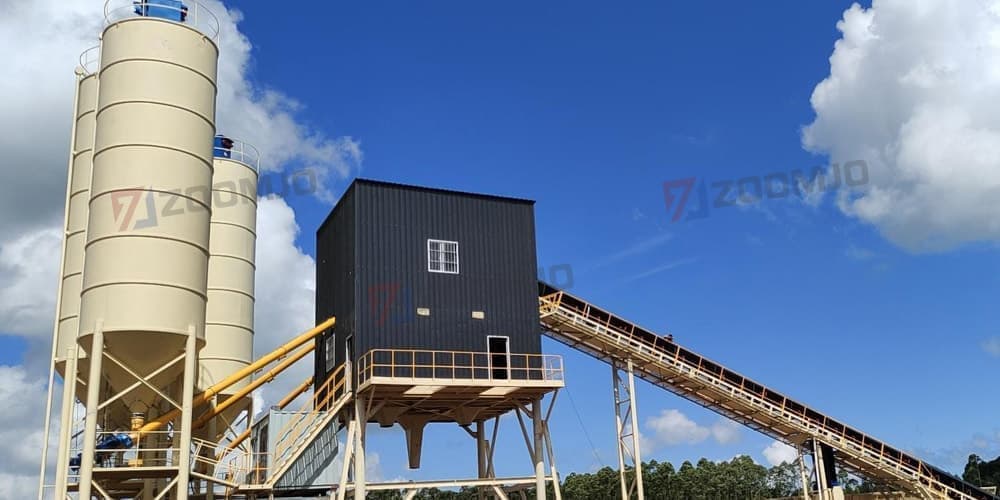
Therefore, investing in a concrete batching plant is an important strategic decision for construction companies or concrete suppliers. Having your own batching plant can:
-
Produce concrete economically: Reduce concrete purchase costs and increase project profits.
-
Better control of concrete quality: Ensure that the quality of concrete meets the project requirements.
-
Flexibility to meet a variety of concrete needs: Ability to produce a variety of concrete types according to project needs.
-
Improve market competitiveness: Provide customers with better quality and more flexible concrete supply services.
For large contractors, having a state-of-the-art batching plant capable of producing high-end construction materials will greatly enhance their competitiveness in the marketplace and provide a solid foundation for taking on more large-scale projects. Batching plants with innovative technologies, such as vibratory mixing technology, represent strong strength and considerate service, and can create greater value for users.
Price Consideration of the Best Concrete Batching Plant
The price of a concrete batching plant varies greatly depending on its size (i.e., production capacity), configuration, and technology level, ranging from a few thousand dollars to hundreds of thousands of dollars. It is not wise to simply pursue the "lowest price", but should consider the performance, quality, after-sales service and long-term operating costs, and choose the most cost-effective equipment. Therefore, the "best price" should be understood as "a reasonable price that matches the performance of the equipment".
In the following, we will discuss the main factors affecting the price with the common types of concrete mixing plant to help you make a better choice:
1. Stationary Concrete Batching Plant
Price range: Usually higher, ranging from a few tens of thousands of dollars to $200,000, depending on model size (e.g., HZS25, HZS50, HZS120, etc.), level of configuration, and degree of automation.
Factors affecting price:
-
Production capacity: The higher the production capacity (e.g. from 25 cubic metres per hour to 120 cubic metres per hour or more), the higher the price.
-
Configuration level: The model of mixing machine, the precision of batching machine, the advanced degree of control system, etc. will affect the price. For example, the use of imported brands or higher performance components, the price is naturally higher.
-
Degree of automation: Fully automatic control system is more expensive than semi-automatic or manual control system, but it can improve the production efficiency and management level.
-
Environmental configuration: equipped with dust, noise reduction, sewage treatment and other environmental protection equipment mixing plant, the price will be relatively high, but in line with environmental requirements, more long-term benefits.
-
Applicable scenario: suitable for large-scale projects, prefabricated component factories, commercial concrete production and other occasions that require a long-term stable supply of concrete.
2. Mobile concrete mixing plant
Price range: Relatively low compared to stationary batching plants, generally ranging from a few thousand US dollars to 100,000 US dollars, again depending on the model size and configuration.
Factors affecting price:
-
Mobility Design: The structural design and load capacity of the trailer chassis will affect the price.
-
Quick mounting and dismounting mechanisms: Mechanisms that allow for quick assembly and dismounting will increase the cost.
-
Configuration level: Similar to the fixed mixing plant, the configuration of the mixing machine, batching plant, control system, etc. will also affect the price.
-
Applicable Scenario: Suitable for projects with short construction period and frequent transfer, such as highway, bridge, hydropower and other projects.
3. foundationless concrete mixing plant
Price range: usually between mobile and fixed, the specific price depends on its special structural design and configuration.
Factors affecting price:
-
Special structural design: Foundation-less designs require more sophisticated construction and higher manufacturing precision, which affects the price.
-
Quick set-up and movement mechanisms: Mechanisms that allow for quick set-up and movement are a key feature, but also add to the cost.
-
Configuration level: The basic configuration is similar to that of a stationary or mobile mixing plant of the same size, and the higher the configuration level, the higher the price.
-
Scenarios: Suitable for projects with complex geological conditions, restricted sites or where rapid deployment is required.
4. Classification according to the way of aggregate conveying
Belt type conveying batching plant:
-
Price: Relatively high, especially for large mixing plants.
-
Factors affecting the price: The length and width of the belt conveyor, the conveying capacity and the material of the belt will affect the price.
-
Applicable scenes: suitable for large-scale, continuous production, long conveying distance occasions.
Hopper lifting batching station:
-
Price: Relatively low, suitable for small and medium-sized mixing plant.
-
Factors affecting the price: Hopper capacity, lifting height, lifting speed, etc. will affect the price.
-
Scenario: Suitable for small and medium-sized projects, construction sites with limited space.
To choose the best concrete mixing plant, you can't just look at the price, but consider the following factors comprehensively:
-
Project demand: Choose the right type and model according to the scale of the project, the amount of concrete, the duration of the project and so on.
-
Production capacity: Choose the appropriate production capacity according to the actual demand, avoid blindly pursuing large models.
-
Configuration level: choose the appropriate configuration according to the budget and project requirements, do not have to blindly pursue high configuration.
-
Quality and reliability: choose well-known brands and reputable manufacturers to ensure the quality of equipment and after-sales service.
-
Long-term operating costs: consider the energy consumption of the equipment, maintenance costs, replacement costs of wearing parts.
By weighing the above factors, choose the concrete mixing plant that matches the performance and price, in order to achieve the best return on investment. It is recommended to make multiple comparisons, field inspections and communicate with multiple suppliers before purchase to get the most suitable solution.
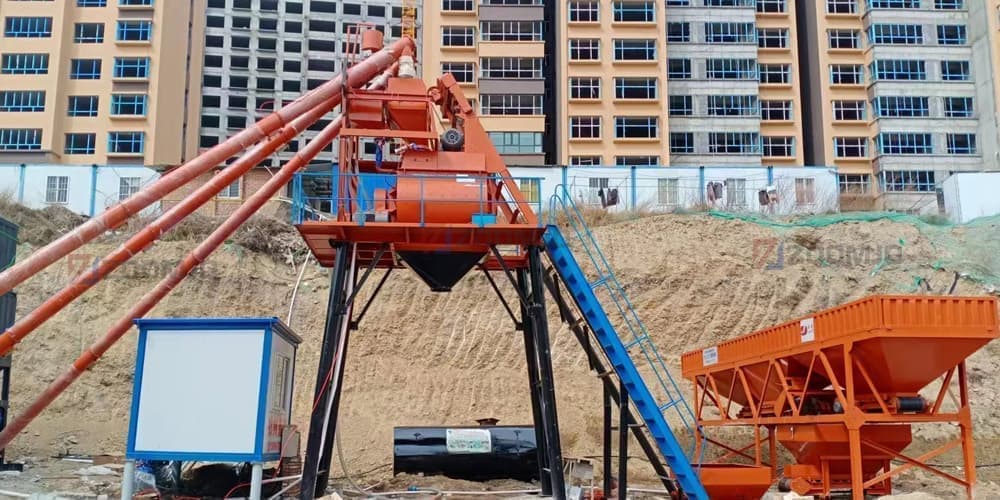
Price range table of various types of mixing plant
Below is a table of price ranges for various types of concrete mixing plants, based on information about common equipment offers on the market:
| Category | Lowest Price (USD) | Maximum Price (USD) |
|---|---|---|
| Stationary Concrete Batching Plant | 28800 | 202850 |
| Mobile Concrete Batching Plant | 8000 | 51870 |
| Concrete mixing plant without foundation | 23500 | 85200 |
| Belt conveyor batching plant | 30000 | 150000 |
| Hopper lifting batching plant | 21000 | 104500 |
It should be emphasised that: the above prices are approximate ranges, the actual price will fluctuate due to the specific configuration and market conditions.
Top Concrete Batching Plant Manufacturers Recommended List
When choosing a concrete mixing plant manufacturer, it is important to know the top brands in the market. Below are some of the globally recognised concrete batching plant manufacturers, recommended based on factors such as their production history, technological innovations and market presence.
1. Sany Heavy Industry (SANY)
Sany Heavy Industry is one of the leading construction machinery manufacturers in China, known for its high-quality concrete mixing equipment. The company offers a wide range of concrete mixing plants worldwide to meet the needs of different customers.
2. ZOOMJO GROUP
ZOOMJO is a professional manufacturer of concrete mixing plants, offering a wide range of models of concrete mixing equipment, including stationary, mobile and portable. The company's equipment is known for its high quality and durability and is suitable for a wide range of construction projects.
3. Liebherr
Liebherr is a Swiss-based multinational company that was founded in 1949. The company offers a wide range of construction and concrete equipment and is known for its high quality and reliability.
4. Putzmeister
Founded in 1958, Putzmeister from Germany specialises in the manufacture of concrete pumps and mixing systems. Its products enjoy a high reputation in the global construction industry.
5. CIFA
Founded in 1928, CIFA is an Italian manufacturer of concrete equipment known for its innovative solutions for concrete production and transport.CIFA's equipment excels in environmental protection and efficiency.
6. MEKA
MEKA is a Turkish company founded in 1987, specialising in the manufacture of equipment for the concrete and aggregates industry.MEKA offers a wide range of concrete mixing plants for projects of different sizes.
7. Vince Hagan Company
Founded in 1956, Vince Hagan is a pioneer in mobile concrete mixing plants, specialising in providing efficient, easy-to-move concrete production equipment.
8. ELKON
Established in 1975, ELKON is the only concrete mixer manufacturer in Turkey, offering a wide range of concrete mixing plants, which are widely used in the global market.
These manufacturers have a good reputation and extensive experience in the field of concrete mixing equipment, and choosing the right brand can help ensure the success and efficiency of your project.
Famous Concrete Batching Plant Manufacturers and Their Popular Models
| Manufacturer | Country | Popular Models | Features |
|---|---|---|---|
| Sany Heavy Industry (SANY) | Sany Heavy Industry (SANY) | HZS270, HZS180 | High quality, widely used in various construction projects |
| ZOOMJO GROUP | China ZOOMJO GROUP | yhzs-75, zjy-120 | High quality and durability for a wide range of construction projects |
| Liebherr | Switzerland | Betomix Series | High quality and reliability for large-scale projects |
| Putzmeister | Germany | PT120, PT240 | High reputation for specialised concrete pumps and mixing systems |
| CIFA | CIFA | Fivetech 1500 | Innovative solutions for concrete production and transport, environmentally friendly and efficient. |
| MEKA | Turkey | M60,M100 | A wide range of mixing plants for different sizes of projects. |
| Vince Hagan Company | Vince Hagan Company | LP Series | The pioneer in mobile concrete mixing plants, efficient and easy to move. |
| ELKON | Turkey | Elkomix-35,Elkomix-60 | Widely used in the global market, offering a wide range of mixing plants. |
Please note:
When choosing a concrete mixing plant manufacturer, factors such as equipment quality, model configuration, price and cost-effectiveness, after-sales service as well as the manufacturer's reputation and experience need to be considered. High quality equipment can ensure production efficiency and stability, while the right model configuration should be customised according to the project scale and demand volume.
In addition, although the price is important, but should not be sacrificed at the expense of quality, it is recommended to shop around and choose cost-effective products. After-sales service is also key, reliable service can reduce the risk of equipment failure brought about by downtime. Finally, choosing a manufacturer with qualifications and a good reputation ensures the quality of the equipment and the guarantee of long-term co-operation.
Frequently Asked Questions about Concrete Batching Plants
1. How do I manage the running costs of my batching plant?
Managing the running costs of a concrete batching plant can be optimised in several ways:
-
Routine maintenance and repair: Regularly check the equipment and repair parts that are about to break down in time to avoid equipment paralysis and production interruption. Good maintenance can extend the service life of the equipment and reduce long-term operating costs.
-
Material Recycling: Recycle reusable materials as much as possible to reduce the waste of raw materials and thus save material costs. This not only helps to reduce costs, but also improves the efficiency of resource utilisation.
-
Optimise production processes: Rationalise production schedules to avoid frequent starting and stopping of equipment and reduce energy consumption. Through data analysis, optimise the production process and improve production efficiency.
2. What is aggregate? How many types of aggregates are there?
Aggregate is a material that acts as a skeleton in concrete and is divided into two main categories:
-
Coarse Aggregate: usually refers to materials with particle size greater than 4.75mm, mainly including pebbles and crushed stone.
-
Fine aggregate: materials with particle size between 0.16mm and 4.75mm, commonly river sand, sea sand, mountain sand and artificial sand.
The choice of aggregate has an important impact on the strength and durability of concrete, so it needs to be reasonably selected according to the requirements of specific projects when proportioning.
3. What are the common failures of concrete mixing plant?
Concrete mixing plant may encounter a variety of faults during operation, mainly including:
-
Inaccurate cement scales: weighing may be inaccurate due to faulty sensors or improper calibration.
-
Bin discharge gate problems: the discharge gate may be difficult to open or close when there is no material available, usually due to a faulty cylinder or solenoid valve problem.
-
Discharge port not discharging material: contactor suction but not discharging material, may be motor reversal or blockage of conveying pipeline.
-
Difficulty in rotating the mixing shaft: the mixing shaft may be difficult to rotate or even stop due to overloading, material jamming or insufficient voltage.
-
Conveyor belt deflection: the conveyor belt may be deflected in operation, which affects the conveying efficiency of materials.
4. What records should the batching plant operator keep?
Dosing plant operators should maintain the following types of records to ensure traceability and quality control of the production process:
-
Production Operation Records: Detailed records of each production operation, including production time, operator, and other information.
-
Mix Ratio Adjustment Records: Records documenting changes made to the mix ratio for subsequent analysis and adjustment.
-
Marking migration record: Record the replacement of raw material model, variety and warehouse number to ensure the accuracy and traceability of materials.
With these records, operators can better manage the production process and ensure the quality and consistency of the concrete.
5. What kind of clean-up is required after the work is finished?
At the end of the work, the operator should clean the accumulated dust inside and outside the mixing drum, clean the discharge door and discharge hopper, and make sure all the equipment is in good condition. In addition, during the freezing season, the water stored in the pump and tank should be drained to prevent freezing and cracking.
6. How long is the maintenance cycle of the concrete mixing plant?
The maintenance cycle of a concrete mixing plant can be summarised as:
-
Daily maintenance: before and after each use.
-
Weekly inspection: carried out regularly to ensure that the equipment is running normally.
-
Monthly inspection: In-depth inspection of key components.
-
Major overhaul: A comprehensive inspection is carried out annually or every 4,000 hours.
By reasonably arranging the maintenance schedule, the productivity of the concrete mixing plant and the stability of the equipment can be effectively improved.

 English
English  Español
Español  简体中文
简体中文  Pусский
Pусский  українська
українська 